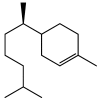Chemical composition and cytotoxicity evaluation of essential oil from leaves of Casearia sylvestris, its main compound α-zingiberene and derivatives
- PMID: 23966073
- PMCID: PMC6269751
- DOI: 10.3390/molecules18089477
Chemical composition and cytotoxicity evaluation of essential oil from leaves of Casearia sylvestris, its main compound α-zingiberene and derivatives
Abstract
Casearia sylvestris (Salicaceae), popularly known as "guaçatonga", is a plant widely used in folk medicine to treat various diseases, including cancer. The present work deals with the chemical composition as well as the cytotoxic evaluation of its essential oil, its main constituent and derivatives. Thus, the crude essential oil from leaves of C. sylvestris was obtained using a Clevenger type apparatus and analyzed by GC/MS. This analysis afforded the identification of 23 substances, 13 of which corresponded to 98.73% of the total oil composition, with sesquiterpene a-zingiberene accounting for 50% of the oil. The essential oil was evaluated for cytotoxic activity against several tumor cell lines, giving IC50 values ranging from 12 to 153 mg/mL. Pure a-zingiberene, isolated from essential oil, was also evaluated against the tumor cell lines showing activity for HeLa, U-87, Siha and HL60 cell lines, but with IC50 values higher than those determined for the crude essential oil. Aiming to evaluate the effect of the double bonds of a-zingiberene on the cytotoxic activity, partially hydrogenated a-zingiberene (PHZ) and fully hydrogenated a-zingiberene (THZ) derivatives were obtained. For the partially hydrogenated derivative only cytotoxic activity to the B16F10-Nex2 cell line (IC50 65 mg/mL) was detected, while totally hydrogenated derivative showed cytotoxic activity for almost all cell lines, with B16F10-Nex2 and MCF-7 as exceptions and with IC50 values ranging from 34 to 65 mg/mL. These results indicate that cytotoxic activity is related with the state of oxidation of compound.
Figures
Similar articles
-
Antifungal activities of the essential oil and its fractions rich in sesquiterpenes from leaves of Casearia sylvestris Sw.An Acad Bras Cienc. 2017 Oct-Dec;89(4):2817-2824. doi: 10.1590/0001-3765201720170339. Epub 2017 Dec 11. An Acad Bras Cienc. 2017. PMID: 29236852
-
α-zingiberene, a sesquiterpene from essential oil from leaves of Casearia sylvestris, suppresses inflammatory angiogenesis and stimulates collagen deposition in subcutaneous implants in mice.Nat Prod Res. 2022 Nov;36(22):5858-5862. doi: 10.1080/14786419.2021.2019729. Epub 2021 Dec 27. Nat Prod Res. 2022. PMID: 34961386
-
Chemical composition and in vitro cytotoxic effects of the essential oil from Nectandra leucantha leaves.Pharm Biol. 2015 Jan;53(1):133-7. doi: 10.3109/13880209.2014.912238. Epub 2014 Oct 23. Pharm Biol. 2015. PMID: 25339603
-
Casearia Essential Oil: An Updated Review on the Chemistry and Pharmacological Activities.Chem Biodivers. 2023 Sep;20(9):e202300492. doi: 10.1002/cbdv.202300492. Epub 2023 Aug 18. Chem Biodivers. 2023. PMID: 37410861 Review.
-
The Clinical Translation of α-humulene - A Scoping Review.Planta Med. 2024 Aug;90(9):664-674. doi: 10.1055/a-2307-8183. Epub 2024 Apr 16. Planta Med. 2024. PMID: 38626911 Free PMC article.
Cited by
-
Recent Advances in the Antiproliferative and Proapoptotic Activity of Various Plant Extracts and Constituents against Murine Malignant Melanoma.Molecules. 2022 Apr 17;27(8):2585. doi: 10.3390/molecules27082585. Molecules. 2022. PMID: 35458783 Free PMC article. Review.
-
(-)-T-Cadinol-a Sesquiterpene Isolated From Casearia sylvestris (Salicaceae)-Displayed In Vitro Activity and Causes Hyperpolarization of the Membrane Potential of Trypanosoma cruzi.Front Pharmacol. 2021 Nov 3;12:734127. doi: 10.3389/fphar.2021.734127. eCollection 2021. Front Pharmacol. 2021. PMID: 34803682 Free PMC article.
-
Chemical basis of unwettability in Liacaridae (Acari, Oribatida): specific variations of a cuticular acid/ester-based system.Exp Appl Acarol. 2015 Jul;66(3):313-35. doi: 10.1007/s10493-015-9914-3. Epub 2015 Apr 28. Exp Appl Acarol. 2015. PMID: 25913033
-
Spatial variation of volatile organic compounds and antioxidant activity of turmeric (Curcuma longa L.) essential oils harvested from four provinces of China.Curr Res Food Sci. 2021 Nov 29;4:882-890. doi: 10.1016/j.crfs.2021.11.002. eCollection 2021. Curr Res Food Sci. 2021. PMID: 34917948 Free PMC article.
-
Chemical investigation and screening of anti-cancer potential of Syzygium aromaticum L. bud (clove) essential oil nanoemulsion.3 Biotech. 2022 Feb;12(2):49. doi: 10.1007/s13205-022-03117-2. Epub 2022 Jan 27. 3 Biotech. 2022. PMID: 35127304 Free PMC article.
References
-
- Souza V.C., Lorenzi H. Botânica Sistemática: Guia Ilustrado Para Identificação das Famílias de Angiosperma da Flora Brasileira, Baseado Em APGII. Instituto Plantarum; Nova Odessa, Brazil: 2005.
-
- Joly A.B. Botânica: Introdução À Taxonomia Vegetal. 12th ed. Companhia Editora Nacional; São Paulo, Brazil: 1998.
-
- Lorenzi H., Matos F.J.A. Plantas Medicinais Do Brasil: Nativas E Exóticas. Instituto Plantarum; Nova Odessa, Brazil: 2008.
-
- Ferreira P.M.P., Costa-Lotufo L.V., Moraes M.O., Barros F.W.A., Martins A.M.A., Cavalheiro A.J., Bolzani V.S., Santos A.G., Pessoa C. Folk uses and pharmacological properties of Casearia sylvestris: A medicinal review. Anais da Academia Brasileira de Ciências. 2011;83:1373–1384. doi: 10.1590/S0001-37652011005000040. - DOI - PubMed
Publication types
MeSH terms
Substances
LinkOut - more resources
Full Text Sources
Other Literature Sources
Miscellaneous




